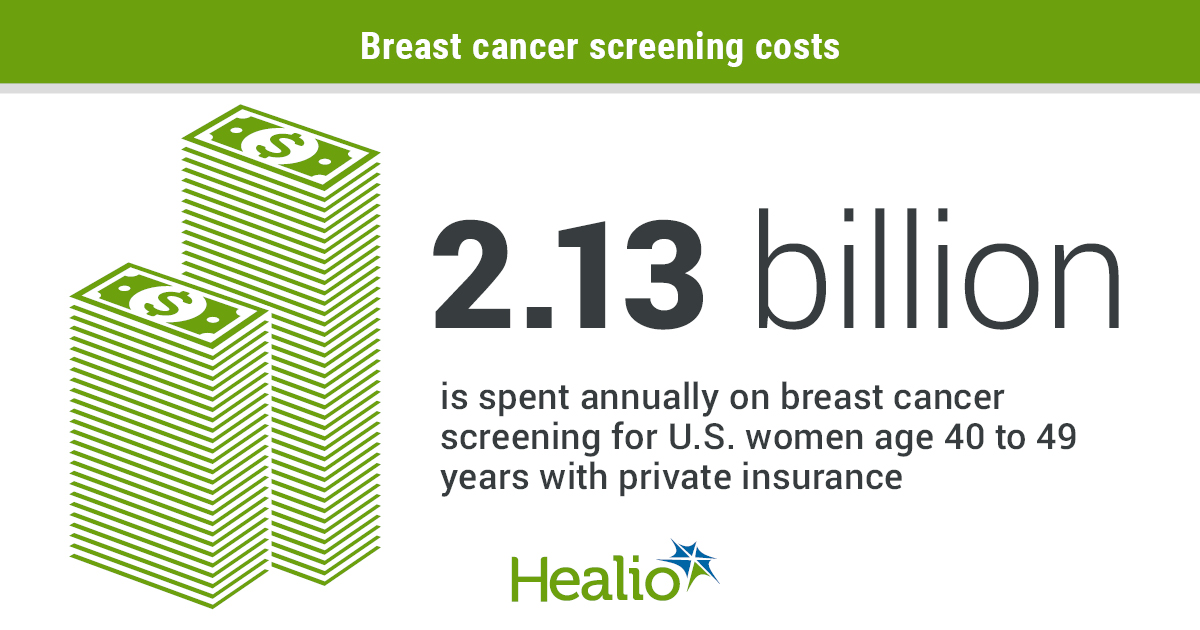Mammography for women aged 40 to 49 years associated with high, widely variable costs

The value of routine screening mammography for women aged 40 to 49 years has been a topic of debate, particularly when weighing the clinical benefits against the risks.
Although guidelines issued by professional societies differ on the age at which women should start annual screening, most private insurance companies will reimburse for the costs of mammography in this younger population. However, information is scarce regarding the cost impact of these screenings.
“Little is known about the actual screening costs among this population in contemporary practice in the U.S.,” Natalia Kunst, MSc, research fellow at Yale University School of Medicine and PhD candidate at University of Oslo, told Healio. “We thought providing this information might be useful to national public health policymakers in making more informed decisions about screening women in their 40s.”
Kunst and colleagues conducted a retrospective study of 2,257,393 privately insured women aged 40 to 49 years who were eligible to receive a screening mammography in 2017.

The researchers used data from Blue Cross Blue Shield Axis, a large commercial claims database. They estimated national screening costs by multiplying the total national number of eligible, privately insured women aged 40 to 49 years by the percentage of women screened and the mean per-beneficiary screening cost.
Kunst spoke with Healio about the study and how it may inform future analyses of routine mammography for women aged 40 to 49 years.
Q: Your study showed that fewer than half (41.2%) of eligible women aged 40 to 49 years with private insurance were screened with mammography in 2017. Is this a high rate?
A: I would not say that it is a low estimate given that it represents the annual percentage of women in their 40s screened. The recommendations for breast cancer screening for women in this age group are inconsistent. For example, the U.S. Preventive Services Task Force and American College of Physicians recommend individual decisions about starting mammography for women aged 40 to 49 years, whereas some other guidelines recommend routine mammography screening for this population. So, considering those inconsistencies, I would say that 40% per year is not a low percentage.
Q: You found that the total national cost of screening women in their 40s was an estimated $2.13 billion per year. What does this mean?
A: This indicates that current screening practices for privately insured women in their 40s are associated with high costs. We also found that these costs varied substantially across the United States. Our findings highlight that more research is needed to further investigate benefits and potential harms of screening women in their 40s. Better understanding of these tradeoffs would help improve the consistency of the guidelines for screening women in their 40s and consequently proper use of U.S. preventive dollars. Currently, the tradeoff between benefits and potential harms of screening this population remains unclear.
Q: What do your findings suggest about the cost-effectiveness of mammography for women aged 40 to 49 years?
A: Our results do not provide any information about the cost-effectiveness of screening this population. To perform a cost-effectiveness analysis, we would need to develop a decision-analytic model that would take into consideration both the costs and effects of different screening strategies. However, the costs identified in our study were higher than the estimates used in previous cost and cost-effectiveness analyses. So, our data may provide important input for future decision-analytic models, to appropriately evaluate cost-effectiveness of screening women in their 40s in the U.S.
Q: What did your study find in terms of regional variation in screening costs?
A:Total annual mean costs of breast cancer screening varied significantly by U.S. region, from $151 (standard deviation [SD], $258) to $751 (SD, $1,100) per beneficiary screened across hospital referral regions. Regional variation was not the main objective of this study, but we are examining it further in our another, currently ongoing study. We are not only looking into the drivers of the regional variation but also into the impact of decreasing this variation on potential national savings. – by Jennifer Byrne
Reference:
Kunst N, et al. JAMA Intern Med. 2020;doi:10.1001/jamainternmed.2020.0262.
For more information:
Natalia Kunst, MSc, can be reached at 333 Cedar St., New Haven, CT 06510.
Disclosure: Kunst reports no relevant financial disclosures.
